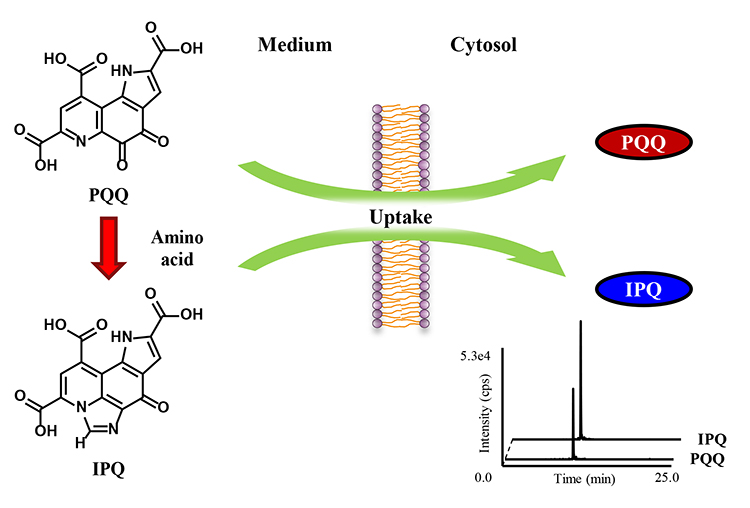- 著者
- Taiki Miyazawa Kiyotaka Nakagawa Hideo Takekoshi Ohki Higuchi Shunji Kato Momoko Kondo Fumiko Kimura Teruo Miyazawa
- 出版者
- 公益社団法人 日本油化学会
- 雑誌
- Journal of Oleo Science (ISSN:13458957)
- 巻号頁・発行日
- vol.62, no.11, pp.873-881, 2013 (Released:2013-11-06)
- 参考文献数
- 22
- 被引用文献数
- 3 25
Accumulation of phospholipid hydroperoxide (PLOOH) in erythrocyte membranes is an abnormality found in patients with senile dementia, including those with Alzheimer’s disease. In our previous studies, dietary xanthophylls (polar carotenoids such as lutein) were hypothesized to inhibit lipid peroxidation. In the present study, we conducted a randomized, double-blind, placebo-controlled human trial to assess the impact for a total of 2 months Chlorella supplementation (8 g Chlorella/day/person; equivalent to 22.9 mg lutein/day/person) on PLOOH and carotenoid concentrations in erythrocytes as well as plasma of 12 normal senior subjects. After 1 or 2 months of treatment, erythrocytes and plasma lutein concentrations increased in the Chlorella group but not in the placebo group. In the Chlorella-supplemented group, erythrocyte PLOOH concentrations after a total of 2 months of treatment were lower than the concentrations before supplementation. These results suggest that Chlorella ingestion improved erythrocyte antioxidant status and lowered PLOOH concentrations. These reductions might contribute to maintaining the normal function of erythrocytes and prevent the development of senile dementia.
- 著者
- Chikara Kato Isabella Supardi Parida Satoshi Maeda Tsuyoshi Mikekado Shunji Kato Susumu Takekoshi Kiyotaka Nakagawa
- 出版者
- Japan Oil Chemists' Society
- 雑誌
- Journal of Oleo Science (ISSN:13458957)
- 巻号頁・発行日
- pp.ess22284, (Released:2022-11-07)
Following a growing interest in the physiological effects of pyrroloquinoline quinone (PQQ), more cell culture experiments have begun to elucidate its mechanism of action. However, to our knowledge, no reports have used instrumental analysis, such as liquid chromatography-tandem mass spectrometry (LC-MS/MS), to study cellular uptake of PQQ. In addition, despite the propensity of PQQ to react with amino acids and other compounds, only a handful of cell culture experiments have been conducted on PQQ derivatives. In the present study, we prepared PQQ derivatives by reacting PQQ with various amino acids and used them as reference standards for optimizing the LC-MS/MS analysis conditions to detect PQQ and its derivatives. Using this method, we evaluated the uptake of PQQ into mouse 3T3-L1 cells and found that most PQQ added to the medium was taken up by the cells in its unchanged form, while some PQQ reacted with amino acids in the medium and was taken up by the cells as PQQ derivatives. These results suggest that PQQ derivatives may contribute to the physiological effects of PQQ. To further elucidate the function of PQQ, it is necessary for future studies to clarify the activity of PQQ derivatives and to evaluate the types of PQQ present in food, animal, and cell samples in more detail.
- 著者
- Naoki Shimizu Hannah Bersabe Junya Ito Shunji Kato Ryo Towada Takahiro Eitsuka Shigefumi Kuwahara Teruo Miyazawa Kiyotaka Nakagawa
- 出版者
- 公益社団法人 日本油化学会
- 雑誌
- Journal of Oleo Science (ISSN:13458957)
- 巻号頁・発行日
- pp.ess16159, (Released:2017-02-10)
- 被引用文献数
- 21
Squalene (SQ), a main component of human sebum, is readily photooxidized by exposure to sunlight, producing six squalene monohydroperoxide (SQ-OOH) isomers. Despite its known connection to various skin conditions, few studies have sought to analyze SQ-OOH at the isomeric level. In this study, we aimed to develop a method to discriminate each SQ-OOH isomer with the use of tandem mass spectrometry (MS/MS). The six standard SQ-OOH isomers were prepared by photooxidizing SQ in the presence of rose bengal, a photosensitizer, and isolated by semipreparative high-performance liquid chromatography (HPLC). To purify each isomer, 2-methoxypropene, which reversibly reacts with the hydroperoxide group of SQ-OOH, was utilized. Product ion scanning was then performed on the standard SQ-OOH isomers in the absence and presence of the sodium ion. In the absence of the sodium ion, the fragmentation patterns produced by atmospheric pressure chemical ionization were similar between the isomers, whereas in the presence of the sodium ion by electrospray ionization, unique fragmentation patterns were achieved. Based on these fragment ions, HPLC-MS/MS multiple reaction monitoring analysis was conducted on a mixture of the standard SQ-OOH isomers. We achieved discrimination of SQ-OOH isomers with high selectivity and detected SQ-OOH isomers at nanogram levels. These results may improve our understanding of the effect of SQ-OOH on skin conditions as well as the mechanism behind SQ peroxidation.
